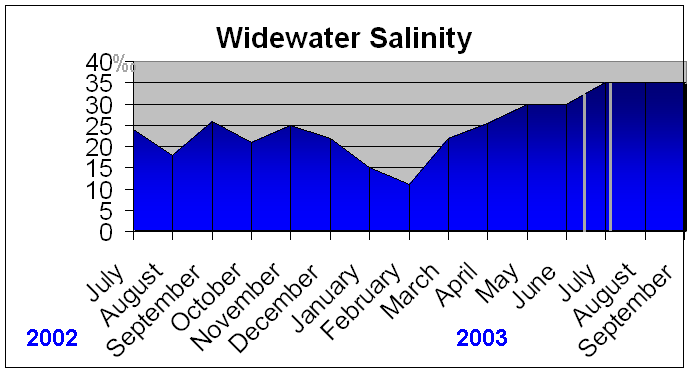
by
Andy
Horton (British Marine Life Study Society)
Widewater Lagoon is usually described as a brackish water lagoon with a level that rises through seawater percolation through the shingle and bottom of the lagoon and through rainfall. In this way the salinity of the lagoon fluctuates wildly according to the state of the tides and the weather.
This gives the lagoon a unique flora and fauna because only a limited number of organisms can survive in both low salinity and almost full strength seawater and these thrive often in the absence of predators that cannot tolerate the extreme conditions. This creates a special habitat recognised by nature conservation agencies and they are under an obligation to monitor and protect these declining habitats for the invertebrate life and other wildlife interests.
Although
by dipping an electronic salinity testing meter into the lagoon at irregular
intervals, it is known that the salinity fluctuates, there has not been
a sustained measurement of the amount of seawater in the lagoon over the
years. The brackish nature is correct because this can be deduced by the
small invertebrate animals and algae (seaweeds) that live in the lagoon.
Monitoring
In the absence of proper monitoring, I took monthly water samples and measured the water temperature and specific gravity of Widewater Lagoon water from July 2002 to February 2004 using an aquarium thermometer with a wide scale calibration to include brackish conditions. The figures are then converted to calculate the salinity which is not precise but accurate enough to monitor the trends in the lagoon.

The
graph above maps out the salinity variations over the last year and a half.
It should be noted that the summer of 2002 was noted for excessive rainfall
which caused a dip in salinity in August 2002 and the maximum salinity
only attained a maximum of 26‰ (parts per thousand) in September 2002.
In winter with more rain the salinity always falls that it reached a low
of 11‰ in March 2003. Thereafter there was a dramatic rise to 22‰ by April
2003. This was as a result of the equinoctial spring tides with the water
percolating through the bed of the lagoon.
The
new pipeline because operational (water actually entering) from the beginning
of July 2003. Initially, the spring tides were low approaching the solstice
and the amount of water entering was small and extensive dried out mud
flats could be seen as the lagoon water had drained out of the bottom of
the lagoon. Because of this the valve on the inlet pipe was adjusted and
by August 2003 the whole lagoon was in flood and the salinity had now attained
35‰ which is the same as full strength seawater. By February 2004, the
salinity had only fallen to 23‰.
This
summer situation was unprecedented with the lagoon level over 50 cm on
the gauge for most of the time and full salinity when the lagoon was in
flood. All the dried out mud flats were then covered in water. The main
loss of water is drained out of the bottom of the lagoon and the amount
lost through evaporation is negligible and unimportant. This means that
hypersaline conditions were not created.
Is
this a Permanent Change?
From
the salinity monitoring since July 2002, the observer could deduce that
because the salinity had risen from a maximum of 26‰ to full strength seawater
of 35% a permanent change was occurring and that the lagoon was turning
into a seawater inlet more like Shoreham harbour canal and that this could
have consequences for the brackish water inhabitants and the whole ecology
of the lagoon. However, this deduction is unfair because it is only based
on a comparison from the wet summer of 2002, and that earlier summer only
readings on a lagoon with a low water level showed that in two out of three
dry summers, the salinity in Widewater Lagoon attained the full level of
35‰ full strength seawater. This means that the summer salinity increase
thought the pipeline was just in line with the natural fluctuations and
would not cause any ecological changes over and above considerable natural
fluctuations.
Winter Levels
Rainfall
and the autumnal equinoctial spring tides causes the winter level of Widewater
Lagoon to rise and an appreciable fall in salinity as the winter progresses
and the cumulative rainfall remains in the lagoon. There would seem to
be no case for elevating the salinity and water levels in winter. The visiting
birds may appreciate a slightly lower level to improve their feeding opportunities.
Summer Levels
In
dry summers the level of Widewater lagoon falls because the water drains
out of the bottom and it is not renewed by either rainfall or the high
spring tides percolating the water through the shingle. This causes the
mud to dry out, to increase the loss of water and it also kills many of
the molluscs, the miniature Hydrobia snail-like (gastropod) molluscs
which are food for visiting birds and the Lagoon
Cockle which experiences huge losses because of desiccation. By operation
of the pipeline during the summer months the invertebrate population can
be increased giving greater feeding opportunities for visiting birds in
the autumn.
Other
Contingencies
Changing
the operation of the lagoon is not without its dangers and possible unforeseen
consequences. Changes in the ecology of the lagoon will be inevitable,
as they are without the pipeline. The pipeline could introduce new organisms
like unattractive seaweeds, plankton blooms that could poison the water,
suspended silt in the water that could accumulate over the years and it
cannot be foreseen exactly what the changes will be. Other small animals
will find their way into the lagoon through the pipeline.